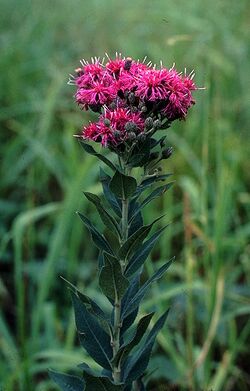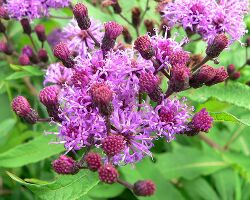Biology:Vernonia
| Vernonia | |
|---|---|

| |
| Vernonia baldwinii | |
| Scientific classification | |
| Kingdom: | Plantae |
| Clade: | Tracheophytes |
| Clade: | Angiosperms |
| Clade: | Eudicots |
| Clade: | Asterids |
| Order: | Asterales |
| Family: | Asteraceae |
| Subfamily: | Vernonioideae |
| Tribe: | Vernonieae |
| Genus: | Vernonia Schreb. |
| Species | |
| Synonyms[1] | |
|
List
| |
Vernonia is a genus of about 350 species of forbs and shrubs in the family Asteraceae.[2] Some species are known as ironweed. Some species are edible and of economic value. They are known for having intense purple flowers. There have been numerous distinct subgenera and subsections named in this genus, and some botanists have divided the genus into several distinct genera.[3][2] For instance, the Flora of North America recognizes only about twenty species in Vernonia sensu stricto, seventeen of which are in North America north of Mexico, with the others being found in South America.[4]
Taxonomy
The genus was circumscribed by Johann Christian Daniel von Schreber in Gen. Pl. ed. 8[a]. vol.2 on page 541 in 1791.[2]
The genus name of Vernonia is in honour of William Vernon (1666/67 - ca.1711), who was an English plant collector, (bryologist) and entomologist from Cambridge University, who collected in Maryland, USA in 1698.[5][6]
Species
Species of this genus are found in South America, Africa, Southeast Asia, and North America. Vernonia species are well known for hybridizing between similar species in areas of overlapping ranges. There are approximately 350 species in the genus.[2] A selected list is given below.
North America
- Vernonia acaulis
- Vernonia arkansana
- Vernonia angustifolia
- Vernonia baldwinii
- Vernonia blodgettii
- Vernonia fasciculata
- Vernonia flaccidifolia
- Vernonia gigantea or Vernonia altissima[7]
- Vernonia glauca
- Vernonia larseniae
- Vernonia lettermannii
- Vernonia lindheimeri
- Vernonia marginata
- Vernonia missurica
- Vernonia noveboracensis
- Vernonia proctorii
- Vernonia pulchella
- Vernonia texana
South America
- Vernonia nonoensis
- Vernonia patens
- Vernonia scorpioides
- Vernonia condensata
Africa
- Vernonia amygdalina
- Vernonia calvoana
- Vernonia colorata
- Vernonia galamensis
- Vernonia kotschyana
- Vernonia staehelinoides
- Vernonia cineria
- vernonia myriantha
Asia
- Vernonia andersoni
- Vernonia arborea
- Vernonia cockburniana
- Vernonia elaeagnifolia
- Vernonia unicata
- Vernonia zollingerianoides
Uses
Several species of Vernonia, including V. calvoana, V. amygdalina, and V. colorata, are eaten as leaf vegetables. Common names for these species include bitterleaf, onugbu in the Igbo language, ewuro and ndole. They are common in most West African and Central African countries. They are one of the most widely consumed leaf vegetables of Nigeria, where the onugbu soup is a local delicacy of the Igbo people, and of Cameroon, where they are a key ingredient of Ndolé: the national dish of Cameroon.[8] The leaves have a sweet and bitter taste. They are sold fresh or dried and are a typical ingredient in egusi soup.
Vernonia galamensis is used as an oilseed in East Africa. It is grown in many parts of Ethiopia, especially around the city of Harar, with an average seed yield of 2 to 2.5 t/ha. It is reported that the Ethiopian strains of Vernonia have the highest oil content, up to 41.9% with up to 80% vernolic acid, and is used in paint formulations, coatings plasticizers, and as a reagent for many industrial chemicals.[9]
Vernonia amygdalina is used in traditional herbal medicine. These leaves are exported from several African countries and can be purchased in grocery stores aiming to serve African clients. In Brazil, V. condensata is commonly known as "figatil" or "necroton" and used in local traditional medicine.[10]
Ecology

Vernonia species are used as food plants by the larvae of some Lepidoptera species including Coleophora vernoniaeella (which feeds exclusively on the genus) and Schinia regia (which feeds exclusively on V. texana). Vernonia is a very diverse genus, varying from the tiny V. desertorum of the Caatinga region of Brazil which is only three inches (8 centimeters) tall[11] to Vernonia arborea of the East Indies which, at 117 feet (36 meters) is the tallest of all composites; a 472 fold difference in height. The liana Vernonia andersoni of Burma, according to Menninger, "climbs into the tops of trees"[12] and could be even taller. The leaves can vary from quite small up to four feet (1.2 meters) long by up to 15 inches (38 centimeters) in width in the case of Vernonia conferta of Cameroon. [13]
References
- ↑ Flann, C (ed) 2009+ Global Compositae Checklist
- ↑ 2.0 2.1 2.2 2.3 "Vernonia Schreb.". Royal Botanical Gardens Kew. https://powo.science.kew.org/taxon/urn:lsid:ipni.org:names:325949-2.
- ↑ Harold Robinson (1999). "Generic and Subtribal Classification of American Vernonieae". Smithsonian Contributions to Botany 89. http://www.sil.si.edu/smithsoniancontributions/Botany/pdf_hi/sctb-0089.pdf. Retrieved 17 September 2014.
- ↑ Flora of North America: Vernonia
- ↑ Burkhardt, Lotte (2022) (in German). Eine Enzyklopädie zu eponymischen Pflanzennamen. Berlin: Botanic Garden and Botanical Museum, Freie Universität Berlin. doi:10.3372/epolist2022. ISBN 978-3-946292-41-8.
- ↑ "Vernon, William (c. 1666-1711) on JSTOR". https://plants.jstor.org/stable/10.5555/al.ap.person.bm000359038.
- ↑ Flora of North America: Vernonia gigantea
- ↑ Veronia calvoana, Plant Encyclopedia
- ↑ "Alamata Pilot Learning Site Diagnosis and Program Design" IPMS Information Resources Portal - Ethiopia (23 June 2005), p. 12 (accessed 3 March 2009)
- ↑ Jucélia Barbosa da Silva et al. (2013). "Vernonia condensata Baker (Asteraceae): A Promising Source of Antioxidants". Oxidative Medicine and Cellular Longevity Article ID 698018: 1–9. doi:10.1155/2013/698018. PMID 24489987.
- ↑ Schemper "Plant Geography on a Physiological Basis p. 313 and figure 203 with caption
- ↑ Menninger, Edwin A. Hon.D.Sc (1970). Flowering Vines of the World. New York: Hearthside Press. p. 141.
- ↑ Karsten and Schenk, Vegetationsbilder, (1911) Volume 8 Plate 40 with caption
Wikidata ☰ Q1411311 entry
 |





